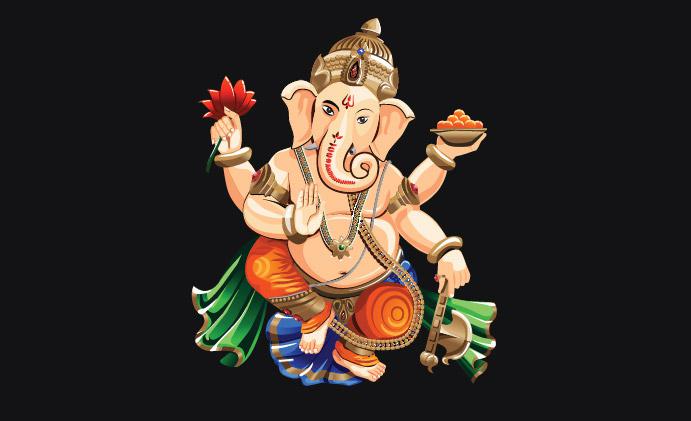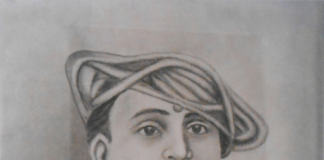Hindus have many Godheads and in various forms. Of all the forms of Godheads two forms stand out. One is that of Ganesha—elephant-headed, pot-bellied. And the other is Hanuman. At least in the case of Hanuman there is a sense of familiarity. With Ganesha, there is a great sense of astonishment. For a Hindu child, this divine form familiarises the unfamiliar. It removes the fear arising out of unfamiliarity.
By Aravindan Neelakandan
The pot-bellied, elephant-headed form of Ganesha, who has a mouse as His mount, is a bundle of paradox. He is an eternal companion for the child and He grows within the heart of the kids.
The first thing a mother may tell a child about Ganesha will be about His five hands.
Five hands? The child may ask.
Apart from the four human-like hands there is the trunk of the elephant-head. The five hands symbolise ‘Panchakritya‘ – the five-process archetypes of the cosmos, within and without. They are the manifestations of reality, its sustenance, its dissolution, the veiling of deeper reality with naïve reality and liberation.
The first three may be considered physical and the last two psychological and spiritual; though all these process archetypes have physical, psychological and spiritual elements.
As the child gets curious about the elephant-face, he or she may be narrated a variety of Puranic anecdotes. And as she gets even more curious, the parent can now walk her through the deeper meaning – the Pranava or Aum-shaped face of Ganesha.
Ganesha Himself is Pranava, the sound symbol of the ultimate reality – the matrix of consciousness.
But what about the tusks? The child may ask.
Again, the Puranic story of Ganesha transcribing the Mahabharata is told. And also the story of Gajamukasura, who could be killed by no other weapon than the tusk of Ganesha.
So, for the subduing of the Asuric element and also for the cultural-literary-spiritual welfare of humanity – one involving punishment and another a benediction- Ganesha broke His own tusk.
As she grows up, the child will learn about the asymmetry of form – the yin- and yang-like nature of the complete and the broken tusk getting integrated in the Divine.
Why do we break a coconut before Ganesha?
Why do we offer Him modaks?
The mother answers sweetly as she prepares the sweets for Ganesha Chaturthi. Look at the hard exterior of coconut. It is not only hard but also has fibres. But when it is broken what comes out? Sweet water!
You too contain within you a sweetness, a nectar. But ego and other impurities harden around that and hide your real nature.
When you break the coconut before Ganesha, you break your ego and other hardened impurities.
Same with modaks. Look at the exterior. It is not sweet. But inside it is. When you are gentle, then as Ganesha consumes you, your true sweet nature emerges. And this is also a very real celebration!
The child learns an important life lesson there.
A day comes when the child, now a teenager, may encounter a pseudo-rationalist, say of the Dravidianist variety. The pseudo-rationalist may laugh at a mouse carrying an elephant form – what a bunch of superstitious people our ancestors were! Perhaps they were hoodwinked by Aryan priest craft with their silly foolish mythologies!
But our teenager with her understanding of our Puranic and sacred imagery answers back. She points out how culturally-challenged pseudo-rationalist misses the deeper reality conveyed by Ganesha.
The Cosmic consciousness that is the matrix and creatrix of all that is, can be experienced in our selves – huge and elephant-like the Being may be and in comparison, mouse-like our puny egos may be; yet if we accept the Being in sacred servitude to all existence then even our egos can become vehicles of the Divine.
And what kind of aesthetics you have? The colonised art critic asks. The child, now a graduate, may answer the art critic politely but firmly—the Hindu aesthetics break the fixed notions of beauty. No muscular Greek Gods and titan our Ganesha is. He combines the beauty in every form: human, animal and non-terrestrial.
The aesthetics of the Hindu, as revealed in the form of Ganesha belongs to the very universe. ‘Critics’ conditioned by colonialism and Marxism can never comprehend that grandeur. The pot belly of Ganesha contains in it all the universes and parallel universes involuted.
Thus Ganesha grows and grows in the child, with him or her. More the growing Hindu contemplates, more deeper and larger Ganesha emerges – verily a Viswarupa for the Bhakta. And what is more, Ganesha appeals to the eternal child inside.
With all the songs, hymns, Puranic stories, celebrations and iconography, a holistic spiritual environment is created for the inner growth of the child.
Call it self-actualisation like Maslow. Or call it individuation if you are a Jungian. But it is all that and more. It is self-realisation. It is living a life beautiful, meaningful and useful for all existence.
This article first appeared in www.swarajyamag.com and it belongs to them.








